Leadership and Management: Theories, Skills, and Reflection
VerifiedAdded on 2020/04/15
|24
|5825
|123
Essay
AI Summary
This essay provides a detailed analysis of leadership and management, addressing key questions about successful leadership, leadership development, the distinction between leadership and management, and self-reflection. The essay explores various leadership theories, including the Great Man Theory, Big Five personalities, Managerial Grid, and Lewin's leadership styles. It also examines contextual and rational approaches such as the Contingency Model, Leader-Member Exchange Theory, Transformational Leadership Theory, and Servant Leadership Theory. Furthermore, the essay compares the roles of managers and leaders and concludes with a self-assessment of the author's leadership skills and experiences. The essay emphasizes the importance of communication, decision-making, and managerial skills for effective leadership.
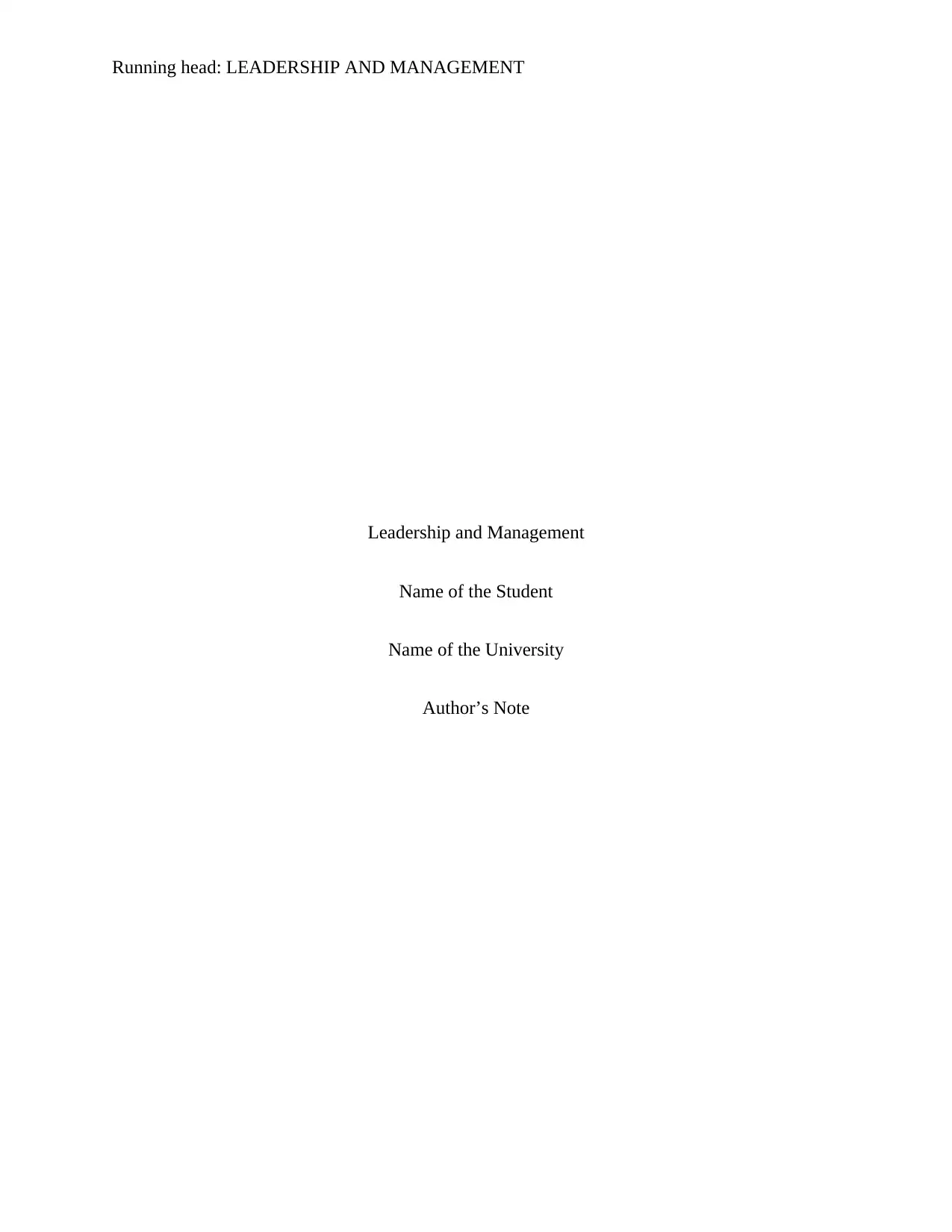
Running head: LEADERSHIP AND MANAGEMENT
Leadership and Management
Name of the Student
Name of the University
Author’s Note
Leadership and Management
Name of the Student
Name of the University
Author’s Note
Paraphrase This Document
Need a fresh take? Get an instant paraphrase of this document with our AI Paraphraser
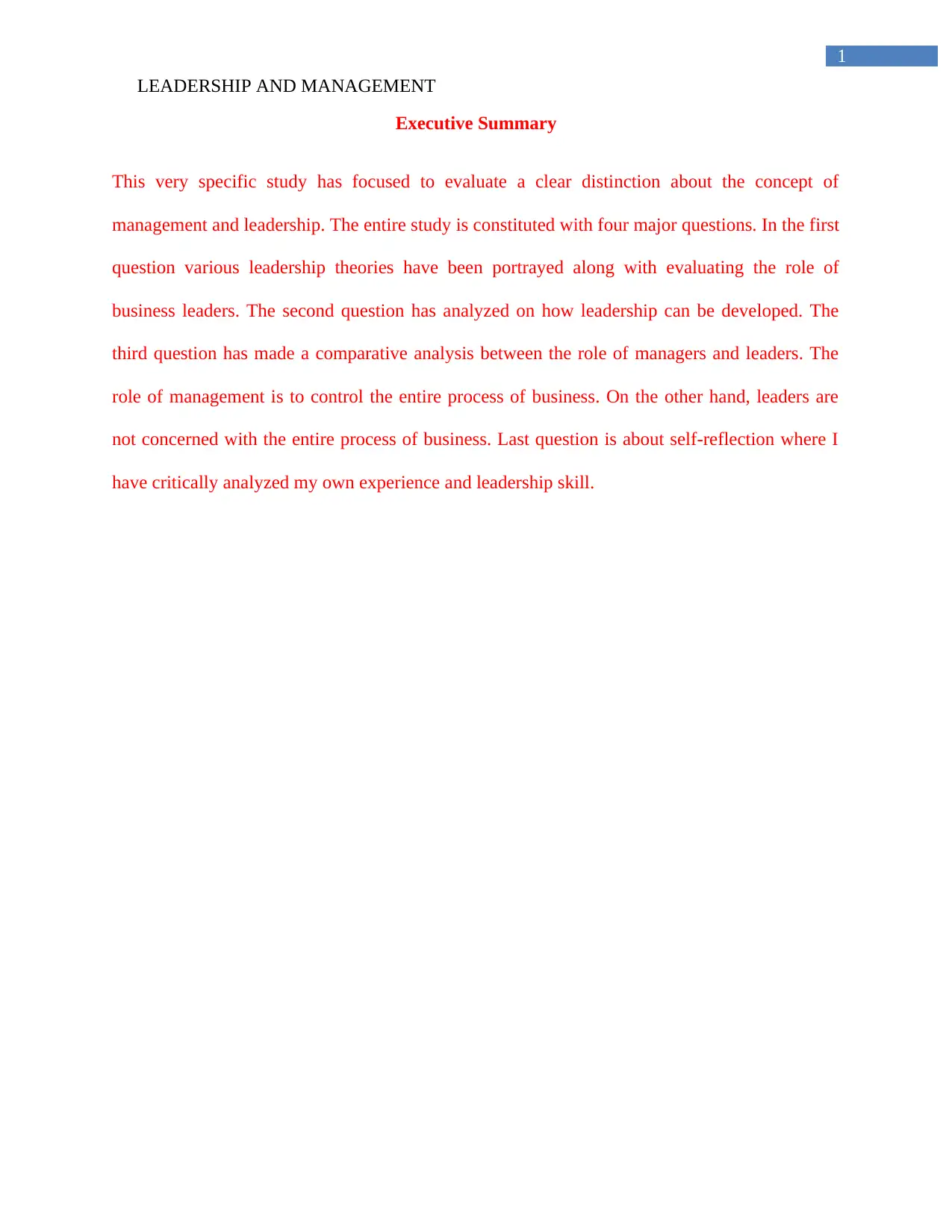
1
LEADERSHIP AND MANAGEMENT
Executive Summary
This very specific study has focused to evaluate a clear distinction about the concept of
management and leadership. The entire study is constituted with four major questions. In the first
question various leadership theories have been portrayed along with evaluating the role of
business leaders. The second question has analyzed on how leadership can be developed. The
third question has made a comparative analysis between the role of managers and leaders. The
role of management is to control the entire process of business. On the other hand, leaders are
not concerned with the entire process of business. Last question is about self-reflection where I
have critically analyzed my own experience and leadership skill.
LEADERSHIP AND MANAGEMENT
Executive Summary
This very specific study has focused to evaluate a clear distinction about the concept of
management and leadership. The entire study is constituted with four major questions. In the first
question various leadership theories have been portrayed along with evaluating the role of
business leaders. The second question has analyzed on how leadership can be developed. The
third question has made a comparative analysis between the role of managers and leaders. The
role of management is to control the entire process of business. On the other hand, leaders are
not concerned with the entire process of business. Last question is about self-reflection where I
have critically analyzed my own experience and leadership skill.

2
LEADERSHIP AND MANAGEMENT
Table of Contents
Introduction:....................................................................................................................................2
Question 1: What is involved in being a successful leader?............................................................3
Question 2: Can good leadership be developed, and if so, how?....................................................6
Question 3: What distinguishes leadership from management?......................................................8
Question 4: What have you learnt about leadership from your own experiences?.......................10
Conclusion:....................................................................................................................................10
Reference List:...............................................................................................................................11
LEADERSHIP AND MANAGEMENT
Table of Contents
Introduction:....................................................................................................................................2
Question 1: What is involved in being a successful leader?............................................................3
Question 2: Can good leadership be developed, and if so, how?....................................................6
Question 3: What distinguishes leadership from management?......................................................8
Question 4: What have you learnt about leadership from your own experiences?.......................10
Conclusion:....................................................................................................................................10
Reference List:...............................................................................................................................11
⊘ This is a preview!⊘
Do you want full access?
Subscribe today to unlock all pages.

Trusted by 1+ million students worldwide
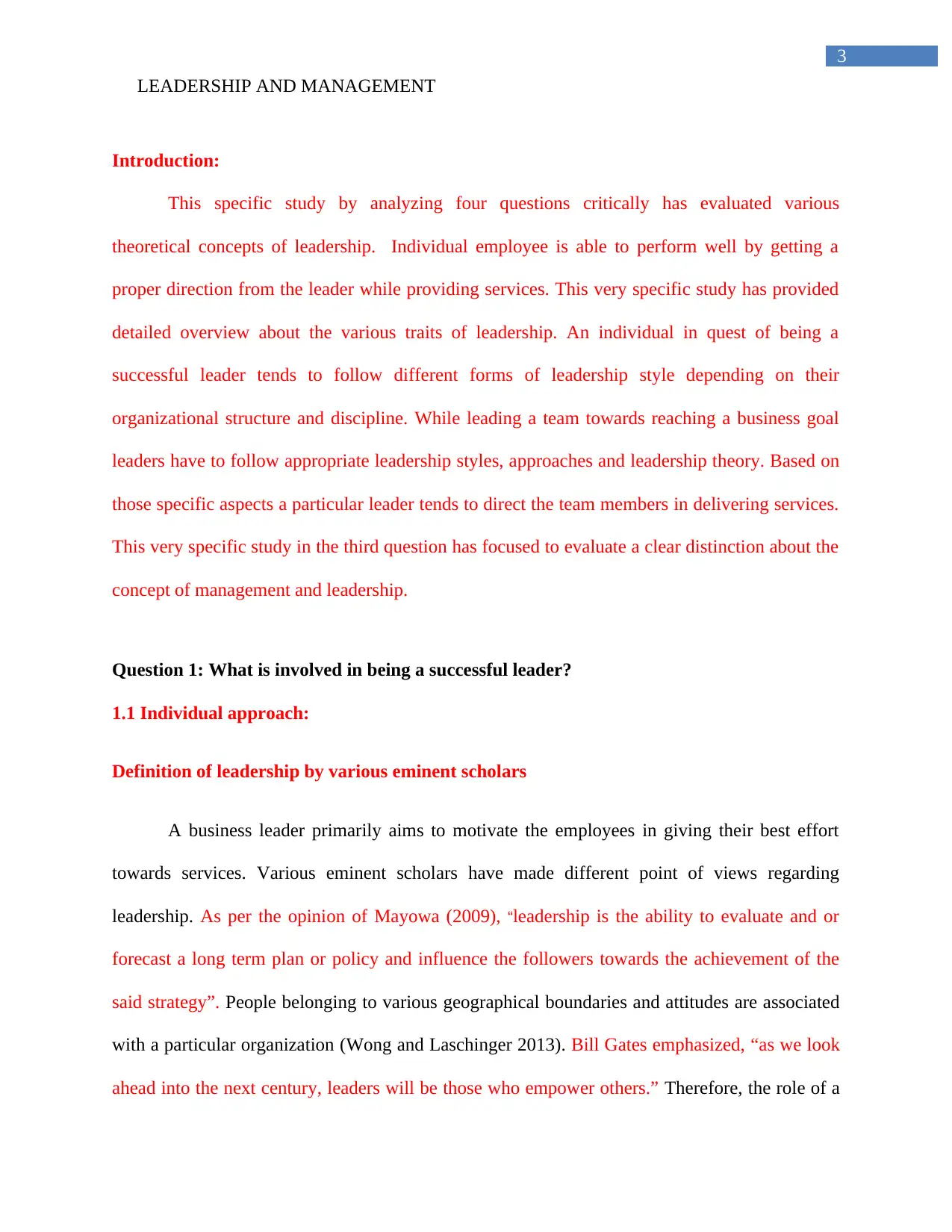
3
LEADERSHIP AND MANAGEMENT
Introduction:
This specific study by analyzing four questions critically has evaluated various
theoretical concepts of leadership. Individual employee is able to perform well by getting a
proper direction from the leader while providing services. This very specific study has provided
detailed overview about the various traits of leadership. An individual in quest of being a
successful leader tends to follow different forms of leadership style depending on their
organizational structure and discipline. While leading a team towards reaching a business goal
leaders have to follow appropriate leadership styles, approaches and leadership theory. Based on
those specific aspects a particular leader tends to direct the team members in delivering services.
This very specific study in the third question has focused to evaluate a clear distinction about the
concept of management and leadership.
Question 1: What is involved in being a successful leader?
1.1 Individual approach:
Definition of leadership by various eminent scholars
A business leader primarily aims to motivate the employees in giving their best effort
towards services. Various eminent scholars have made different point of views regarding
leadership. As per the opinion of Mayowa (2009), “leadership is the ability to evaluate and or
forecast a long term plan or policy and influence the followers towards the achievement of the
said strategy”. People belonging to various geographical boundaries and attitudes are associated
with a particular organization (Wong and Laschinger 2013). Bill Gates emphasized, “as we look
ahead into the next century, leaders will be those who empower others.” Therefore, the role of a
LEADERSHIP AND MANAGEMENT
Introduction:
This specific study by analyzing four questions critically has evaluated various
theoretical concepts of leadership. Individual employee is able to perform well by getting a
proper direction from the leader while providing services. This very specific study has provided
detailed overview about the various traits of leadership. An individual in quest of being a
successful leader tends to follow different forms of leadership style depending on their
organizational structure and discipline. While leading a team towards reaching a business goal
leaders have to follow appropriate leadership styles, approaches and leadership theory. Based on
those specific aspects a particular leader tends to direct the team members in delivering services.
This very specific study in the third question has focused to evaluate a clear distinction about the
concept of management and leadership.
Question 1: What is involved in being a successful leader?
1.1 Individual approach:
Definition of leadership by various eminent scholars
A business leader primarily aims to motivate the employees in giving their best effort
towards services. Various eminent scholars have made different point of views regarding
leadership. As per the opinion of Mayowa (2009), “leadership is the ability to evaluate and or
forecast a long term plan or policy and influence the followers towards the achievement of the
said strategy”. People belonging to various geographical boundaries and attitudes are associated
with a particular organization (Wong and Laschinger 2013). Bill Gates emphasized, “as we look
ahead into the next century, leaders will be those who empower others.” Therefore, the role of a
Paraphrase This Document
Need a fresh take? Get an instant paraphrase of this document with our AI Paraphraser
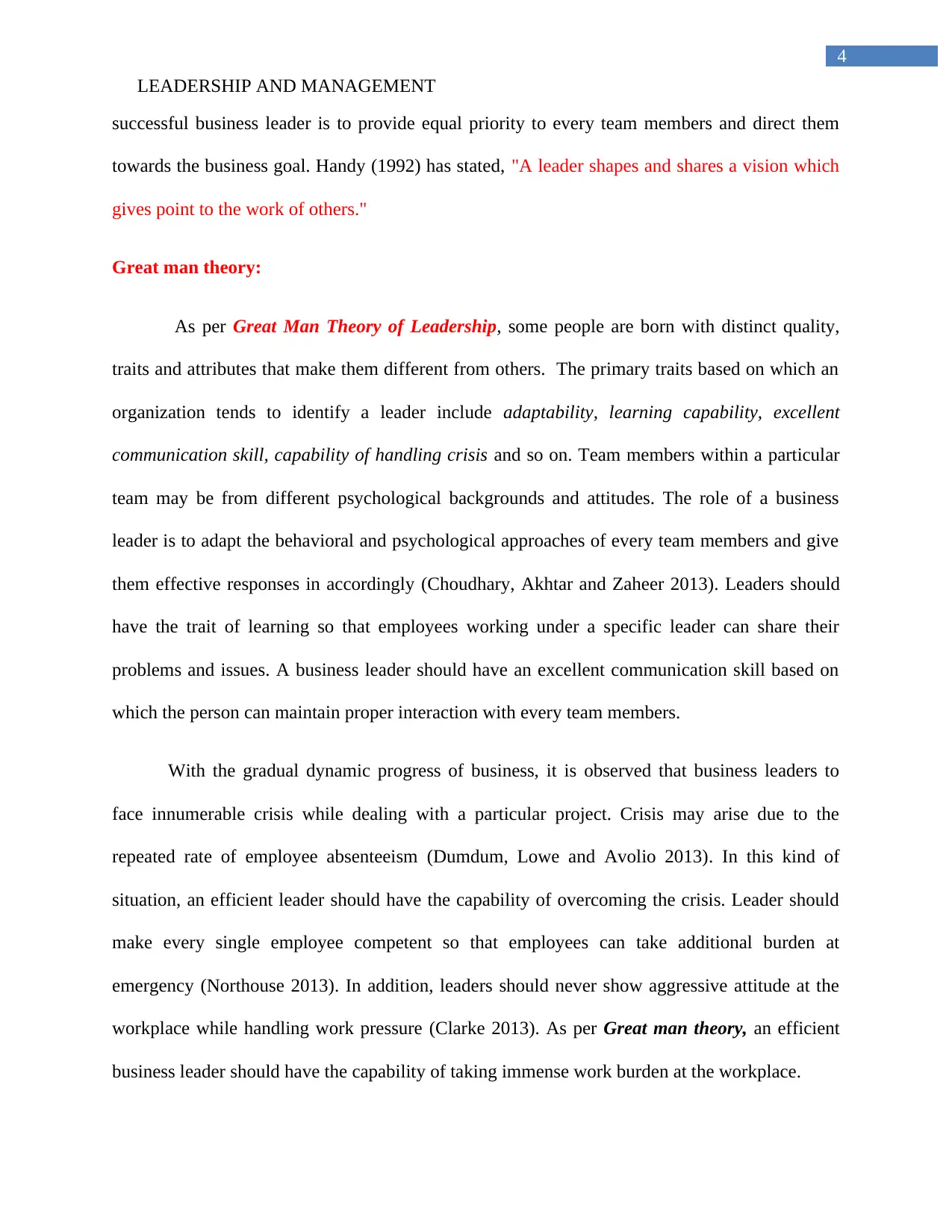
4
LEADERSHIP AND MANAGEMENT
successful business leader is to provide equal priority to every team members and direct them
towards the business goal. Handy (1992) has stated, "A leader shapes and shares a vision which
gives point to the work of others."
Great man theory:
As per Great Man Theory of Leadership, some people are born with distinct quality,
traits and attributes that make them different from others. The primary traits based on which an
organization tends to identify a leader include adaptability, learning capability, excellent
communication skill, capability of handling crisis and so on. Team members within a particular
team may be from different psychological backgrounds and attitudes. The role of a business
leader is to adapt the behavioral and psychological approaches of every team members and give
them effective responses in accordingly (Choudhary, Akhtar and Zaheer 2013). Leaders should
have the trait of learning so that employees working under a specific leader can share their
problems and issues. A business leader should have an excellent communication skill based on
which the person can maintain proper interaction with every team members.
With the gradual dynamic progress of business, it is observed that business leaders to
face innumerable crisis while dealing with a particular project. Crisis may arise due to the
repeated rate of employee absenteeism (Dumdum, Lowe and Avolio 2013). In this kind of
situation, an efficient leader should have the capability of overcoming the crisis. Leader should
make every single employee competent so that employees can take additional burden at
emergency (Northouse 2013). In addition, leaders should never show aggressive attitude at the
workplace while handling work pressure (Clarke 2013). As per Great man theory, an efficient
business leader should have the capability of taking immense work burden at the workplace.
LEADERSHIP AND MANAGEMENT
successful business leader is to provide equal priority to every team members and direct them
towards the business goal. Handy (1992) has stated, "A leader shapes and shares a vision which
gives point to the work of others."
Great man theory:
As per Great Man Theory of Leadership, some people are born with distinct quality,
traits and attributes that make them different from others. The primary traits based on which an
organization tends to identify a leader include adaptability, learning capability, excellent
communication skill, capability of handling crisis and so on. Team members within a particular
team may be from different psychological backgrounds and attitudes. The role of a business
leader is to adapt the behavioral and psychological approaches of every team members and give
them effective responses in accordingly (Choudhary, Akhtar and Zaheer 2013). Leaders should
have the trait of learning so that employees working under a specific leader can share their
problems and issues. A business leader should have an excellent communication skill based on
which the person can maintain proper interaction with every team members.
With the gradual dynamic progress of business, it is observed that business leaders to
face innumerable crisis while dealing with a particular project. Crisis may arise due to the
repeated rate of employee absenteeism (Dumdum, Lowe and Avolio 2013). In this kind of
situation, an efficient leader should have the capability of overcoming the crisis. Leader should
make every single employee competent so that employees can take additional burden at
emergency (Northouse 2013). In addition, leaders should never show aggressive attitude at the
workplace while handling work pressure (Clarke 2013). As per Great man theory, an efficient
business leader should have the capability of taking immense work burden at the workplace.

5
LEADERSHIP AND MANAGEMENT
Big five personalities:
The five personalities based on which an eminent leader should be possessed with
include Openness, Conscientiousness, Extraversion, Agreeableness, Neuroticism. Openness
implies the courageous and energetic attitude that a leader should have in running the entire
team.
Figure 1: Five Personality types
(Source: Keskes 2014)
Employees get proper motivation from their leaders. Therefore, over introvert may
hamper the energy level and determination of the employees as well. Conscientiousness is the
LEADERSHIP AND MANAGEMENT
Big five personalities:
The five personalities based on which an eminent leader should be possessed with
include Openness, Conscientiousness, Extraversion, Agreeableness, Neuroticism. Openness
implies the courageous and energetic attitude that a leader should have in running the entire
team.
Figure 1: Five Personality types
(Source: Keskes 2014)
Employees get proper motivation from their leaders. Therefore, over introvert may
hamper the energy level and determination of the employees as well. Conscientiousness is the
⊘ This is a preview!⊘
Do you want full access?
Subscribe today to unlock all pages.

Trusted by 1+ million students worldwide
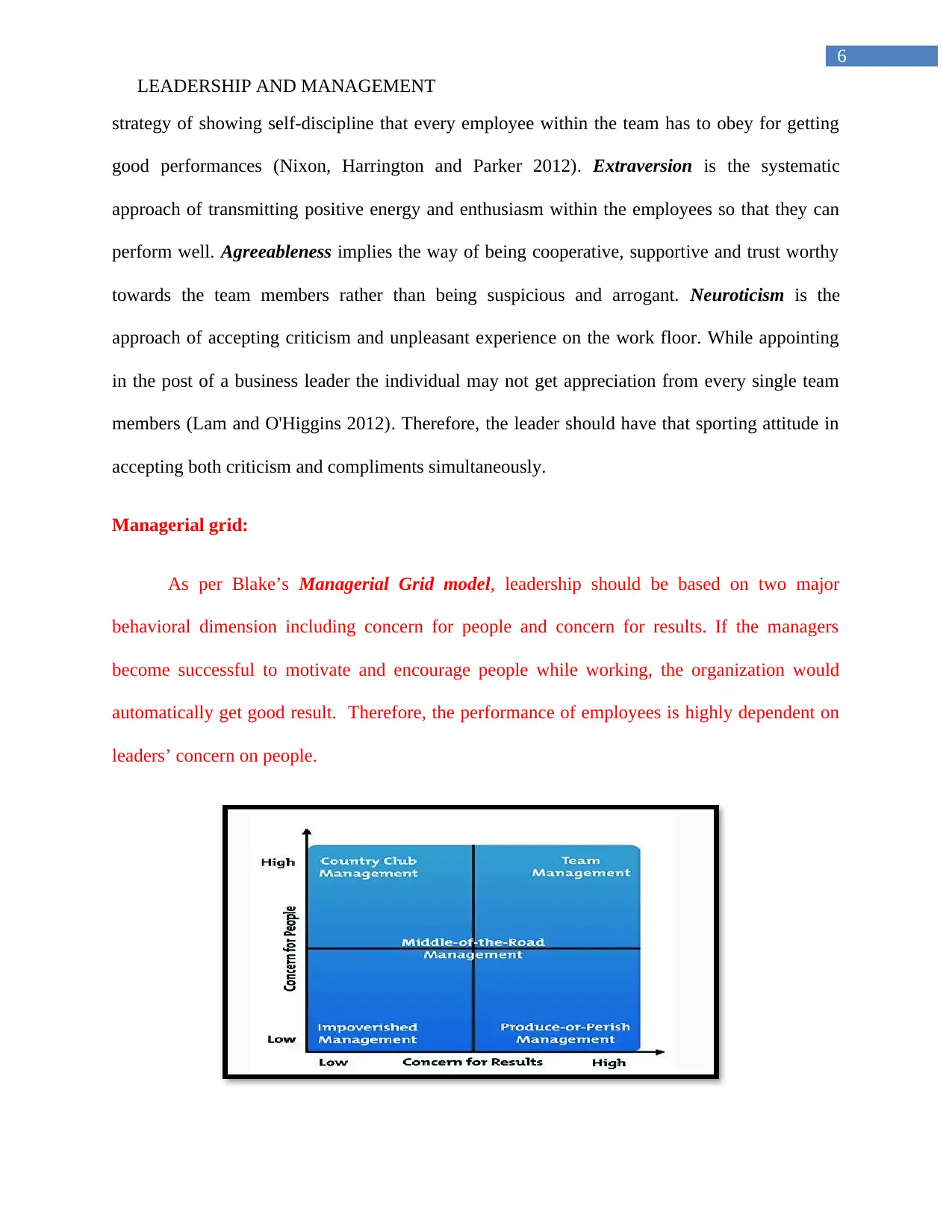
6
LEADERSHIP AND MANAGEMENT
strategy of showing self-discipline that every employee within the team has to obey for getting
good performances (Nixon, Harrington and Parker 2012). Extraversion is the systematic
approach of transmitting positive energy and enthusiasm within the employees so that they can
perform well. Agreeableness implies the way of being cooperative, supportive and trust worthy
towards the team members rather than being suspicious and arrogant. Neuroticism is the
approach of accepting criticism and unpleasant experience on the work floor. While appointing
in the post of a business leader the individual may not get appreciation from every single team
members (Lam and O'Higgins 2012). Therefore, the leader should have that sporting attitude in
accepting both criticism and compliments simultaneously.
Managerial grid:
As per Blake’s Managerial Grid model, leadership should be based on two major
behavioral dimension including concern for people and concern for results. If the managers
become successful to motivate and encourage people while working, the organization would
automatically get good result. Therefore, the performance of employees is highly dependent on
leaders’ concern on people.
LEADERSHIP AND MANAGEMENT
strategy of showing self-discipline that every employee within the team has to obey for getting
good performances (Nixon, Harrington and Parker 2012). Extraversion is the systematic
approach of transmitting positive energy and enthusiasm within the employees so that they can
perform well. Agreeableness implies the way of being cooperative, supportive and trust worthy
towards the team members rather than being suspicious and arrogant. Neuroticism is the
approach of accepting criticism and unpleasant experience on the work floor. While appointing
in the post of a business leader the individual may not get appreciation from every single team
members (Lam and O'Higgins 2012). Therefore, the leader should have that sporting attitude in
accepting both criticism and compliments simultaneously.
Managerial grid:
As per Blake’s Managerial Grid model, leadership should be based on two major
behavioral dimension including concern for people and concern for results. If the managers
become successful to motivate and encourage people while working, the organization would
automatically get good result. Therefore, the performance of employees is highly dependent on
leaders’ concern on people.
Paraphrase This Document
Need a fresh take? Get an instant paraphrase of this document with our AI Paraphraser

7
LEADERSHIP AND MANAGEMENT
Figure 2: Managerial Grid Model
(Source: Keskes 2014)
Katz’s three skill approaches:
As per Katz’s three skill approaches, a particular business leader should have include
technical skill, human skill and conceptual skill. With the advanced process of technology, the
business leaders should have competency so that employees do not have to struggle in meeting
business due to sudden technological barrier. It is undeniable at the same time that technological
skill itself is not sufficient enough for becoming a proficient business leader (Kapp 2012). The
leader should have appropriate human skill as well based on which the individual would like to
maintain effective communication with every team member. The leader should make an
enthusiastic attitude towards the team members. As a result, employees would like to perform
well for achieving the business goal. Conceptual skill allows a business leader in focusing on
work, which is amalgamated with ideas (Keskes 2014). The leaders before implementing a
particular strategy and policy have to think about the future and its appreciation level. If the
employees are not comfortable in accepting the strategy the leaders have to change the strategy
at once for giving priority on employees’ thoughts and emotions.
Lewin leadership style:
As per Lewin, leadership style is possessed with several types including participative
form of leadership, autocratic form of leadership and transformational form of leadership
style and laissez-fair style of leadership. In participative leadership style, leaders do not like to
impose their own decision on the employees. Employees are comfortable in sharing their views
and ideas in reaching the business goal. As a result, both the leaders and the employees have
LEADERSHIP AND MANAGEMENT
Figure 2: Managerial Grid Model
(Source: Keskes 2014)
Katz’s three skill approaches:
As per Katz’s three skill approaches, a particular business leader should have include
technical skill, human skill and conceptual skill. With the advanced process of technology, the
business leaders should have competency so that employees do not have to struggle in meeting
business due to sudden technological barrier. It is undeniable at the same time that technological
skill itself is not sufficient enough for becoming a proficient business leader (Kapp 2012). The
leader should have appropriate human skill as well based on which the individual would like to
maintain effective communication with every team member. The leader should make an
enthusiastic attitude towards the team members. As a result, employees would like to perform
well for achieving the business goal. Conceptual skill allows a business leader in focusing on
work, which is amalgamated with ideas (Keskes 2014). The leaders before implementing a
particular strategy and policy have to think about the future and its appreciation level. If the
employees are not comfortable in accepting the strategy the leaders have to change the strategy
at once for giving priority on employees’ thoughts and emotions.
Lewin leadership style:
As per Lewin, leadership style is possessed with several types including participative
form of leadership, autocratic form of leadership and transformational form of leadership
style and laissez-fair style of leadership. In participative leadership style, leaders do not like to
impose their own decision on the employees. Employees are comfortable in sharing their views
and ideas in reaching the business goal. As a result, both the leaders and the employees have
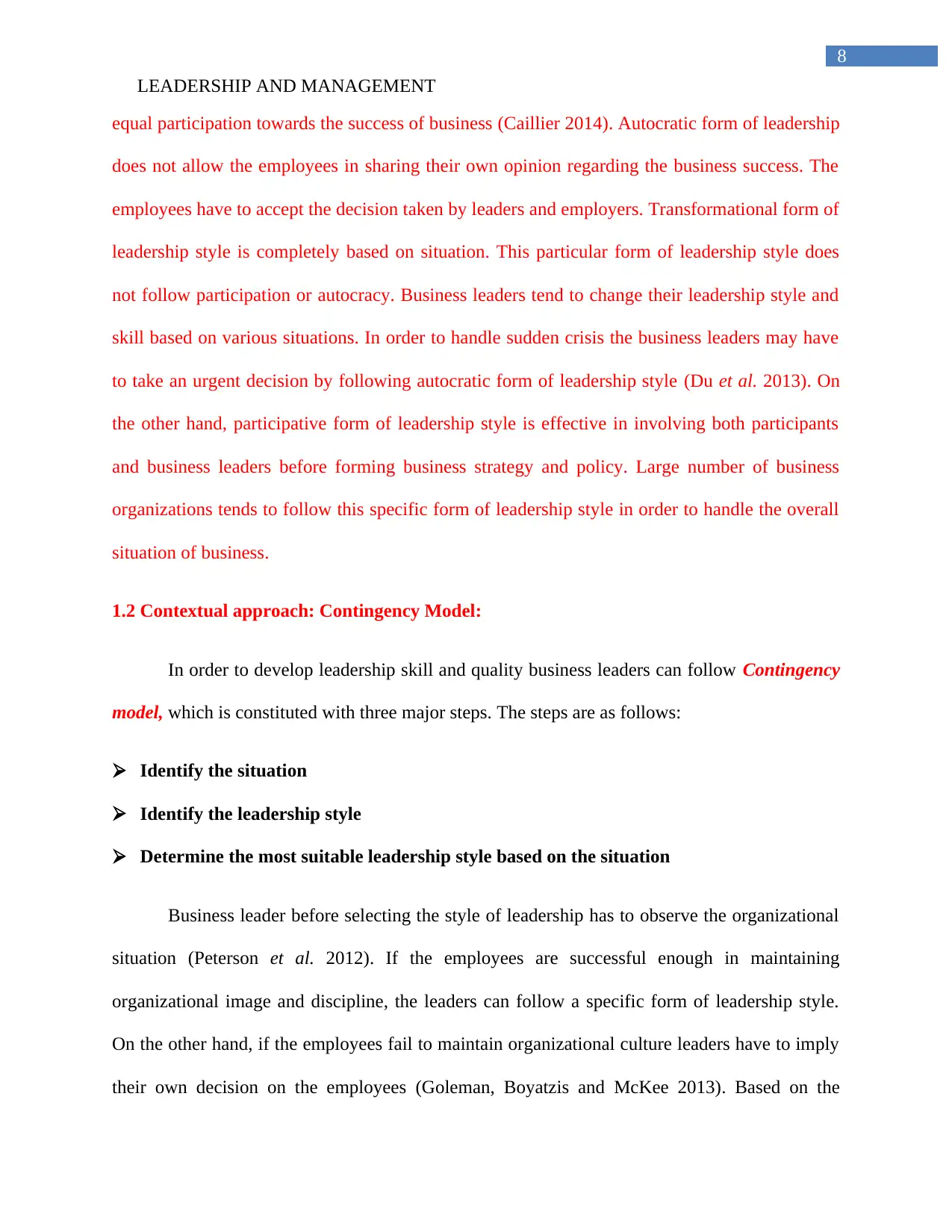
8
LEADERSHIP AND MANAGEMENT
equal participation towards the success of business (Caillier 2014). Autocratic form of leadership
does not allow the employees in sharing their own opinion regarding the business success. The
employees have to accept the decision taken by leaders and employers. Transformational form of
leadership style is completely based on situation. This particular form of leadership style does
not follow participation or autocracy. Business leaders tend to change their leadership style and
skill based on various situations. In order to handle sudden crisis the business leaders may have
to take an urgent decision by following autocratic form of leadership style (Du et al. 2013). On
the other hand, participative form of leadership style is effective in involving both participants
and business leaders before forming business strategy and policy. Large number of business
organizations tends to follow this specific form of leadership style in order to handle the overall
situation of business.
1.2 Contextual approach: Contingency Model:
In order to develop leadership skill and quality business leaders can follow Contingency
model, which is constituted with three major steps. The steps are as follows:
Identify the situation
Identify the leadership style
Determine the most suitable leadership style based on the situation
Business leader before selecting the style of leadership has to observe the organizational
situation (Peterson et al. 2012). If the employees are successful enough in maintaining
organizational image and discipline, the leaders can follow a specific form of leadership style.
On the other hand, if the employees fail to maintain organizational culture leaders have to imply
their own decision on the employees (Goleman, Boyatzis and McKee 2013). Based on the
LEADERSHIP AND MANAGEMENT
equal participation towards the success of business (Caillier 2014). Autocratic form of leadership
does not allow the employees in sharing their own opinion regarding the business success. The
employees have to accept the decision taken by leaders and employers. Transformational form of
leadership style is completely based on situation. This particular form of leadership style does
not follow participation or autocracy. Business leaders tend to change their leadership style and
skill based on various situations. In order to handle sudden crisis the business leaders may have
to take an urgent decision by following autocratic form of leadership style (Du et al. 2013). On
the other hand, participative form of leadership style is effective in involving both participants
and business leaders before forming business strategy and policy. Large number of business
organizations tends to follow this specific form of leadership style in order to handle the overall
situation of business.
1.2 Contextual approach: Contingency Model:
In order to develop leadership skill and quality business leaders can follow Contingency
model, which is constituted with three major steps. The steps are as follows:
Identify the situation
Identify the leadership style
Determine the most suitable leadership style based on the situation
Business leader before selecting the style of leadership has to observe the organizational
situation (Peterson et al. 2012). If the employees are successful enough in maintaining
organizational image and discipline, the leaders can follow a specific form of leadership style.
On the other hand, if the employees fail to maintain organizational culture leaders have to imply
their own decision on the employees (Goleman, Boyatzis and McKee 2013). Based on the
⊘ This is a preview!⊘
Do you want full access?
Subscribe today to unlock all pages.

Trusted by 1+ million students worldwide
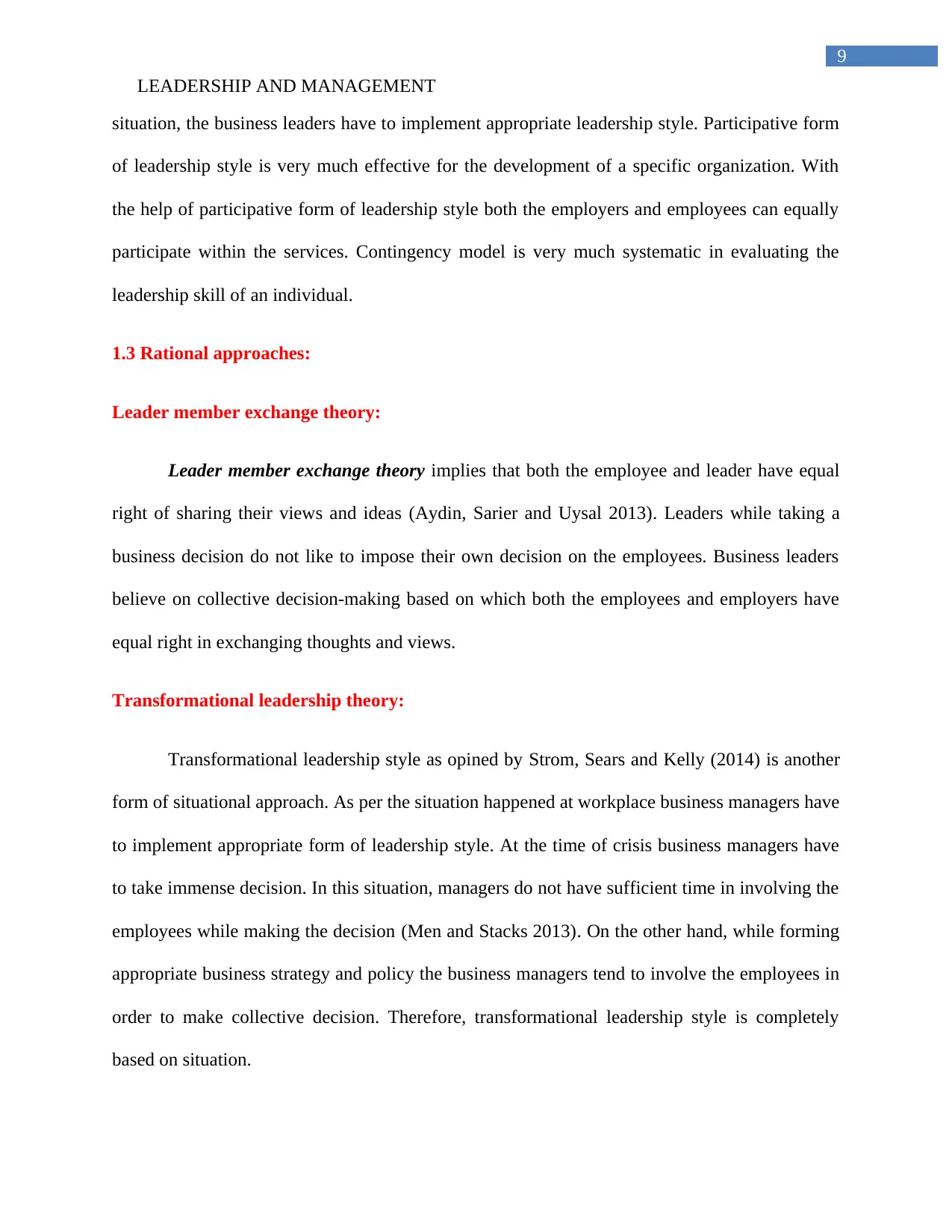
9
LEADERSHIP AND MANAGEMENT
situation, the business leaders have to implement appropriate leadership style. Participative form
of leadership style is very much effective for the development of a specific organization. With
the help of participative form of leadership style both the employers and employees can equally
participate within the services. Contingency model is very much systematic in evaluating the
leadership skill of an individual.
1.3 Rational approaches:
Leader member exchange theory:
Leader member exchange theory implies that both the employee and leader have equal
right of sharing their views and ideas (Aydin, Sarier and Uysal 2013). Leaders while taking a
business decision do not like to impose their own decision on the employees. Business leaders
believe on collective decision-making based on which both the employees and employers have
equal right in exchanging thoughts and views.
Transformational leadership theory:
Transformational leadership style as opined by Strom, Sears and Kelly (2014) is another
form of situational approach. As per the situation happened at workplace business managers have
to implement appropriate form of leadership style. At the time of crisis business managers have
to take immense decision. In this situation, managers do not have sufficient time in involving the
employees while making the decision (Men and Stacks 2013). On the other hand, while forming
appropriate business strategy and policy the business managers tend to involve the employees in
order to make collective decision. Therefore, transformational leadership style is completely
based on situation.
LEADERSHIP AND MANAGEMENT
situation, the business leaders have to implement appropriate leadership style. Participative form
of leadership style is very much effective for the development of a specific organization. With
the help of participative form of leadership style both the employers and employees can equally
participate within the services. Contingency model is very much systematic in evaluating the
leadership skill of an individual.
1.3 Rational approaches:
Leader member exchange theory:
Leader member exchange theory implies that both the employee and leader have equal
right of sharing their views and ideas (Aydin, Sarier and Uysal 2013). Leaders while taking a
business decision do not like to impose their own decision on the employees. Business leaders
believe on collective decision-making based on which both the employees and employers have
equal right in exchanging thoughts and views.
Transformational leadership theory:
Transformational leadership style as opined by Strom, Sears and Kelly (2014) is another
form of situational approach. As per the situation happened at workplace business managers have
to implement appropriate form of leadership style. At the time of crisis business managers have
to take immense decision. In this situation, managers do not have sufficient time in involving the
employees while making the decision (Men and Stacks 2013). On the other hand, while forming
appropriate business strategy and policy the business managers tend to involve the employees in
order to make collective decision. Therefore, transformational leadership style is completely
based on situation.
Paraphrase This Document
Need a fresh take? Get an instant paraphrase of this document with our AI Paraphraser
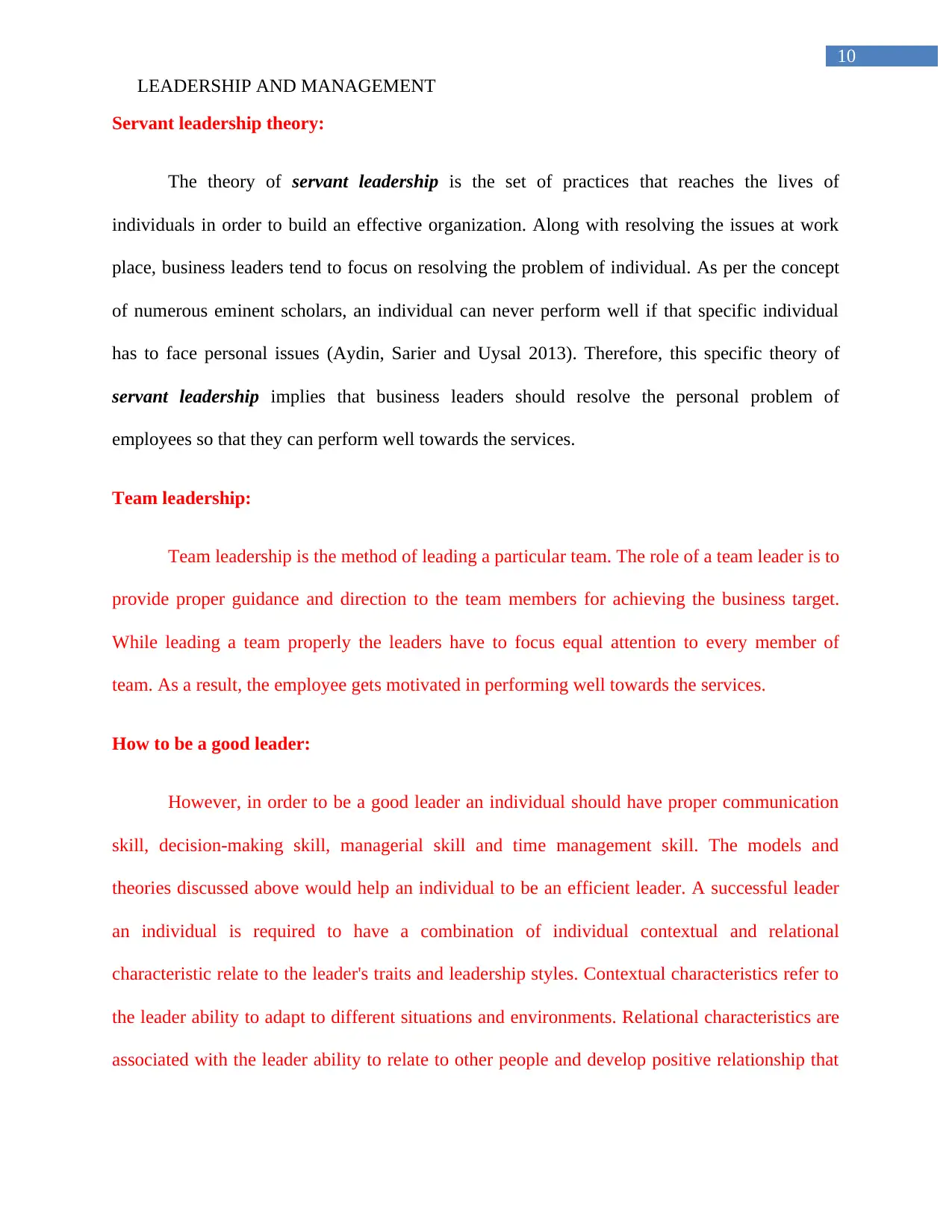
10
LEADERSHIP AND MANAGEMENT
Servant leadership theory:
The theory of servant leadership is the set of practices that reaches the lives of
individuals in order to build an effective organization. Along with resolving the issues at work
place, business leaders tend to focus on resolving the problem of individual. As per the concept
of numerous eminent scholars, an individual can never perform well if that specific individual
has to face personal issues (Aydin, Sarier and Uysal 2013). Therefore, this specific theory of
servant leadership implies that business leaders should resolve the personal problem of
employees so that they can perform well towards the services.
Team leadership:
Team leadership is the method of leading a particular team. The role of a team leader is to
provide proper guidance and direction to the team members for achieving the business target.
While leading a team properly the leaders have to focus equal attention to every member of
team. As a result, the employee gets motivated in performing well towards the services.
How to be a good leader:
However, in order to be a good leader an individual should have proper communication
skill, decision-making skill, managerial skill and time management skill. The models and
theories discussed above would help an individual to be an efficient leader. A successful leader
an individual is required to have a combination of individual contextual and relational
characteristic relate to the leader's traits and leadership styles. Contextual characteristics refer to
the leader ability to adapt to different situations and environments. Relational characteristics are
associated with the leader ability to relate to other people and develop positive relationship that
LEADERSHIP AND MANAGEMENT
Servant leadership theory:
The theory of servant leadership is the set of practices that reaches the lives of
individuals in order to build an effective organization. Along with resolving the issues at work
place, business leaders tend to focus on resolving the problem of individual. As per the concept
of numerous eminent scholars, an individual can never perform well if that specific individual
has to face personal issues (Aydin, Sarier and Uysal 2013). Therefore, this specific theory of
servant leadership implies that business leaders should resolve the personal problem of
employees so that they can perform well towards the services.
Team leadership:
Team leadership is the method of leading a particular team. The role of a team leader is to
provide proper guidance and direction to the team members for achieving the business target.
While leading a team properly the leaders have to focus equal attention to every member of
team. As a result, the employee gets motivated in performing well towards the services.
How to be a good leader:
However, in order to be a good leader an individual should have proper communication
skill, decision-making skill, managerial skill and time management skill. The models and
theories discussed above would help an individual to be an efficient leader. A successful leader
an individual is required to have a combination of individual contextual and relational
characteristic relate to the leader's traits and leadership styles. Contextual characteristics refer to
the leader ability to adapt to different situations and environments. Relational characteristics are
associated with the leader ability to relate to other people and develop positive relationship that

11
LEADERSHIP AND MANAGEMENT
will support their vision. In order to become an efficient leader an individual should have both
contextual and rational characteristics.
Question 2: Can good leadership be developed, and if so, how?
2.1 Can leadership be developed, is it born or made?
Different eminent scholars have provided point of views about the skill of leadership. ()
stated that leadership is a skill that can be developed with the gradual experiences gathered at the
workplace. This specific scholar has opined that leadership quality is not a born talent. It has to
be gained while working at the work floor.
2.2 How can you develop leadership?
Numerous eminent scholars have pointed out that good leadership can be developed by
taking an effective training and guidance from the senior managers as well as professional
trainers. It is observed that business leaders sometimes fail to draw the attention of employees.
Employees do not intend to perform well due to the lack of appropriate leadership style within
the team. As a result, the organizational productivity is hampered effectively. Different eminent
scholars have expressed their own point of view regarding the on how to develop the style of
leadership within organization. Carter and Greer (2013) stated that superior guidance from the
senior employees is one of the most effective ways based on which business leaders can groom
up. On the other hand, in order to evaluate the skill and competency the leaders can attend
coaching and development session as well. This particular coaching and development session
can help the business leaders in reaching the business goal. Monitoring is one of the most
effective ways of rendering development on leadership. Junior leaders can consider the seniors as
their mention while delivering the services (Kelloway et al. 2012). As a result, the junior
LEADERSHIP AND MANAGEMENT
will support their vision. In order to become an efficient leader an individual should have both
contextual and rational characteristics.
Question 2: Can good leadership be developed, and if so, how?
2.1 Can leadership be developed, is it born or made?
Different eminent scholars have provided point of views about the skill of leadership. ()
stated that leadership is a skill that can be developed with the gradual experiences gathered at the
workplace. This specific scholar has opined that leadership quality is not a born talent. It has to
be gained while working at the work floor.
2.2 How can you develop leadership?
Numerous eminent scholars have pointed out that good leadership can be developed by
taking an effective training and guidance from the senior managers as well as professional
trainers. It is observed that business leaders sometimes fail to draw the attention of employees.
Employees do not intend to perform well due to the lack of appropriate leadership style within
the team. As a result, the organizational productivity is hampered effectively. Different eminent
scholars have expressed their own point of view regarding the on how to develop the style of
leadership within organization. Carter and Greer (2013) stated that superior guidance from the
senior employees is one of the most effective ways based on which business leaders can groom
up. On the other hand, in order to evaluate the skill and competency the leaders can attend
coaching and development session as well. This particular coaching and development session
can help the business leaders in reaching the business goal. Monitoring is one of the most
effective ways of rendering development on leadership. Junior leaders can consider the seniors as
their mention while delivering the services (Kelloway et al. 2012). As a result, the junior
⊘ This is a preview!⊘
Do you want full access?
Subscribe today to unlock all pages.

Trusted by 1+ million students worldwide
1 out of 24
Related Documents
Your All-in-One AI-Powered Toolkit for Academic Success.
+13062052269
info@desklib.com
Available 24*7 on WhatsApp / Email
![[object Object]](/_next/static/media/star-bottom.7253800d.svg)
Unlock your academic potential
Copyright © 2020–2025 A2Z Services. All Rights Reserved. Developed and managed by ZUCOL.




